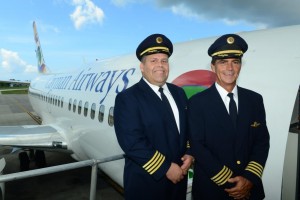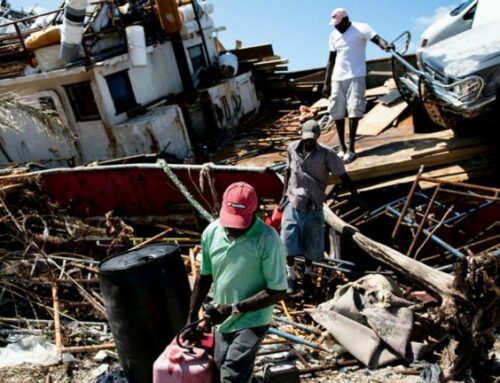 As the Cayman Islands humbly observes the 10th anniversary of hurricane Ivan – the category five hurricane which devastated Grand Cayman on September 11, 2004 – Cayman Airways Limited (CAL) reaffirms the vital role the national airline played during that difficult time, and continues to play in the country’s disaster recovery plan.
As the Cayman Islands humbly observes the 10th anniversary of hurricane Ivan – the category five hurricane which devastated Grand Cayman on September 11, 2004 – Cayman Airways Limited (CAL) reaffirms the vital role the national airline played during that difficult time, and continues to play in the country’s disaster recovery plan.
Cayman Airways President & CEO, Fabian Whorms, who was the Vice President of Maintenance and Engineering when Ivan struck in 2004, stated: “Cayman Airways operated an unprecedented 26 evacuation flights from Grand Cayman to Florida prior to this category five hurricane hitting the island, with the last evacuation flight departing on the morning of September 11, 2004 for Tampa,” Mr. Whorms said. “While staff performed a herculean task to make this happen, it was in the days and weeks immediately after Hurricane Ivan that our national airline truly showed its spirit and dedication to the country, at whatever cost, or challenge.”
Mr. Whorms explained that all aircraft were relocated to Houston to wait out the storm, and crew members, along with other essential staff, were sent to be on standby in Tampa, Miami and Houston. “As soon as the go-ahead was obtained from the necessary authorities in Cayman to resume operations after the storm, our crew immediately flew back to Grand Cayman to start the recovery process and continue with evacuations,” Mr. Whorms said. “In the immediate aftermath, operational hours were ‘daylight only’ due to safety and security reasons, and in the absence of telephone lines, satellite phones had to be used for essential communications.”
Suspending its normal commercial flight schedule indefinitely, Cayman Airways successfully operated approximately 15 evacuation flights during the first two days following Ivan to Kingston, Tampa, Miami and Cayman Brac. “Within the first 10 days following Hurricane Ivan, Cayman Airways evacuated approximately 10,000 people from Grand Cayman,” Mr. Whorms confirmed.
At that time, the airline’s cargo service was also suspended to accommodate relief flights.
Rina Ebanks, Manager Corporate Security, was a senior flight attendant at the time of hurricane Ivan, and recalls the many emotions expressed by passengers and crew during the post-hurricane evacuations. “We had to console so many passengers on the flights who lost their homes and everything they owned,” she said. “It was so sad to fly over Grand Cayman and see the mass destruction from the air, that we would all cry every time we returned home.”
With the airline’s administrative and ticket offices being rendered un-inhabitable, Cayman Airways staff operated out of the maintenance hangar where there was less damage. After a few days, operations moved to the main terminal at Owen Roberts International Airport, and the reservations team was relocated to Miami in order to maintain phone communications with customers.
“While we managed to get up and running almost immediately after the storm, this was against a backdrop where our entire operational infrastructure was severely disrupted – from our ability to issue tickets, to our ability to maintain our aircraft,” Mr. Whorms noted. “Airline operations are complex on good days when everything is running right, and to suddenly find ourselves without our infrastructure proved that we had some of the most talented, brilliant, and dedicated airline managers and staff on the planet, because we immediately found ways to accomplish everything using alternate means.”
Mr. Whorms explained that all functions that were automated had to be accomplished manually and in make shift offices and work spaces. “With our operations control center unusable and much of our tooling, equipment and aircraft spare parts damaged or destroyed by the flood from the storm surge, we had to quickly make alternate arrangements that were acceptable to the Civil Aviation Authority (CAA) in order to ensure that we continued our operations safe and compliant with all aviation regulations. This involved making immediate arrangements in Miami and other stations so that we had the ability to maintain our aircraft, and also involved dispatching staff to those stations to oversee and conduct the required maintenance.”
For any of this to be possible, Mr. Whorms said the airline’s employees took it upon themselves to go far above and beyond the call of duty, often having suffered immense personal loss to their own homes and property. Many left their homes at dawn and returned at dusk just to assist with the operations, obtaining special permission from the authorities due to a national night time curfew in force. “I remember seeing some of our flight attendants wearing only a Cayman Airways uniform vest or scarf over a T-shirt with jeans boarding our aircraft to go to work, and it hit home that even when some of our staff lost most, or all, of their personal belongings in the hurricane, their spirit to get their jobs done, no matter what, was so prevailing,” he said.
Mr. Whorms particularly remembers the selfless dedication of then-CEO, Mike Adam, who also lost so much personally to hurricane Ivan, but gave more than his all to the airline in the aftermath. “He basically worked around the clock for several days in his shorts and T-shirt, keeping the Cayman Airways fabric together,” Mr. Whorms shared. “His example made us all buckle down and do the same.”
As for lessons learned as a result of 2004’s hurricane Ivan, Larry Tibbetts, Manager Corporate Safety, says the national airline now has a more robust and comprehensive Hurricane Preparedness Plan in place. “Recognizing the need for early activation, we now have a pre-alert of 96 hours (if allowable based on travel distance and forward speed of the storm) and the alert phase which is 72 hours prior,” he explained.
As the primary carrier in the evacuation of persons from the Cayman Islands, Mr. Tibbetts added that Cayman Airways collaborates closely with the “Mass Evacuation Group” for the Cayman Islands Airport Authority (CIAA). “We also have now moved towards ensuring a comprehensive Business Continuity Plan is in place in order to return to a position where we can provide essential services as quickly as possible after a disaster,” he said. “We also have other customer assistance provisions such as Hurricane Fares and, due to crowd congestion at the airport, we have worked closely with them to enhance our staging areas for more reasonable passenger convenience.”
The significance of the efforts and accomplishments made by Cayman Airways before and after hurricane Ivan in 2004 should never be underestimated, stressed the airline’s leader, Mr. Whorms: “Mass evacuation is an essential component of a disaster recovery plan and Cayman Airways established itself very much at the forefront of that effort after hurricane Ivan,” he said. “Cayman Airways was the last airline to operate scheduled flights from Grand Cayman prior to hurricane Ivan hitting. All other carriers cancelled their service 36 to 48 hours before, because of the threat of the storm. Cayman Airways continued to do its duty to the very last hour, and continues to serve our islands faithfully.”





